Transferts monétaires et mobilité humaine
Les transferts monétaires sont souvent utilisés lors de crises afin de répondre aux besoins des personnes migrantes. Dans cette page, vous trouverez des ressources sur les transferts monétaires et la migration.

La Croix-Rouge se prépare à fournir une aide humanitaire aux migrant·es de la caravane sur le point de quitter le Honduras pour le Guatemala.
©Johannes Chinchilla / FICR.
Conflits, crises économiques et catastrophes sont autant de raisons ayant contraint des personnes à fuir et à traverser des frontières dans des conditions éprouvantes et risquées, en quête de sécurité et de moyens de subsistance. En 2020, le nombre de personnes déplacées de force s’est envolé au niveau sans précédent de plus de 80 millions de personnes, soit près du double du nombre enregistré il y a une dizaine d’année. Cette tendance s’aggrave et les effets du changement climatique menacent de déplacer jusqu’à 200 millions de personnes d’ici 2050.
L’assistance monétaire est de plus en plus utilisée afin de répondre aux besoins des personnes en situation de déplacement. On y a eu recours à grande échelle dans différents contextes de migration, en Europe en 2015 jusqu’au Venezuela pour « los caminantes ». Elle a également été utilisée dans d’autres crises migratoires, notamment en Amérique centrale, au Sahel, en Méditerranée et dans la Corne de l’Afrique. L’assistance monétaire est à l’heure actuelle l’une des principales formes d’aide apportée aux populations déplacées en Ukraine et dans les pays voisins.
Il existe une myriade de perspectives et de définitions concernant le mot « migrant·e » et la façon dont les humanitaires doivent agir. C’est pourquoi nous ne choisissons pas une définition unique pour le moment, étant donné que les discussions sur l’assistance monétaire et la migration en sont encore à leurs prémices et que le langage évolue encore.
Documenter et partager les données probantes donnera lieu à des interventions plus efficaces. Cette page contient une sélection de ressources utiles concernant la migration et le recours à l’assistance monétaire. Elle sera mise à jour au fil des discussions ayant lieu dans les espaces humanitaires des transferts monétaires.
Priorités actuelles
Afin de contribuer aux progrès relatifs à cet enjeu, nous nous engageons à :
- soutenir la création de données probantes aux niveaux régional et mondial ;
- contribuer aux solutions pratiques visant à mettre en œuvre les transferts monétaires auprès des personnes migrantes ;
- organiser des discussions sur les enjeux majeurs basées sur des données probantes.
Contenu récent
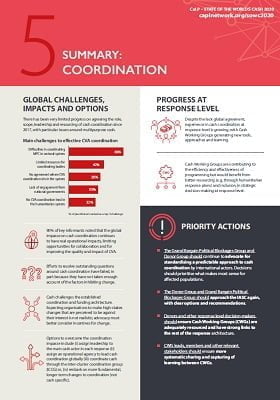
State of the World’s Cash 2020 Chapter 5 summary: Coordination
Report
There has been very limited progress on cash coordination since 2017. Cash continues to challenge the established coordination and funding architecture, and efforts to resolve outstanding questions around cash coordination have failed. Despite the lack of global agreement, Cash Working Groups are pushing...
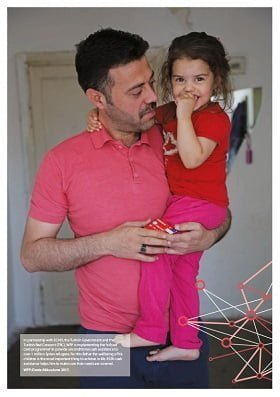
State of the World’s Cash 2020 – Chapter 4: Build sufficient capacity for cash and voucher assistance
Report
Since 2018 individual and organisational CVA capacities have improved, and are having a positive impact on the timeliness and scale of CVA. But dedicated funding for CVA capacity building is generally insufficient and unpredictable and recruiting and retaining skilled staff remains a challenge. This...
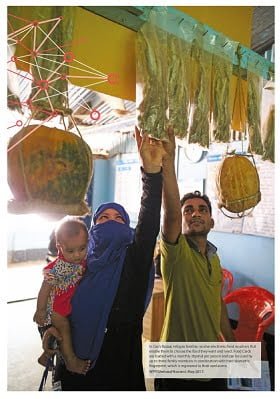
State of the World’s Cash 2020 – Chapter 6B: Investing in innovation for CVA
Report
Since 2017, the appetite for CVA innovation has decreased slightly as has the percentage of practitioners (46%) who agree that humanitarian agencies and private sector actors are developing effective working relationships in CVA programmes. Despite this, digital finance and the use of mobile money has...
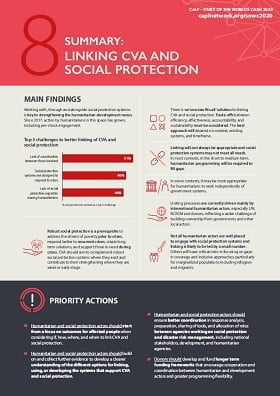
State of the World’s Cash 2020 Chapter 8 summary: Linking CVA and social protection
Report
Longstanding efforts to strengthen links between humanitarian CVA and social protection have been accelerated by the COVID-19 pandemic, with significant progress since the last report. CVA should aim to complement robust social protection systems where they exist and contribute to their strengthening...
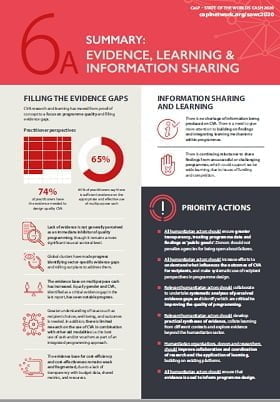
State of the World’s Cash 2020 – Chapter 6A summary: Evidence, learning & information sharing
Report
Three-quarters of practitioners agree that they have the evidence needed to design quality CVA. However some critical evidence gaps remain for example around recipient choice and wellbeing, cost effectiveness and the use of CVA in combination with other aid modalities. This chapter asks: ‘How can...
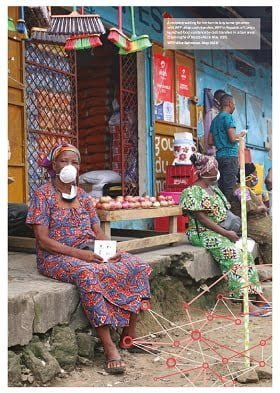
State of the World’s Cash 2020 – Chapter 9: COVID-19 and CVA – Impacts and Implications of the Crisis and Response
Report
CVA is being scaled up significantly in response to COVID-19, but the overall gap between needs and funding is growing rapidly. The pandemic has incurred an extraordinary human cost, but also presents an opportunity to redefine the humanitarian system to better serve the needs of crisis-affected people....

The State of the World’s Cash 2020 Report: Global Launch
Webinar
This 90-minute webinar and Q&A will launch The State of the World’s Cash 2020 Report, present a complete picture of the state of CVA in 2020, and explore how we can all work together to better meet the needs of crisis affected people. The State of the World’s Cash 2020 draws on inputs from hundreds of...
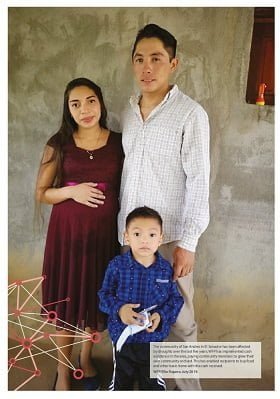
State of the World’s Cash 2020 – Chapter 8: Linkages between SP and CVA
Report
Longstanding efforts to strengthen links between humanitarian CVA and social protection have been accelerated by the COVID-19 pandemic, with significant progress since the last report. CVA should aim to complement robust social protection systems where they exist and contribute to their strengthening...

State of the World’s Cash 2020 Chapter 1 Summary: Funding, Policies, Volume and Collaboration
Report
In the past four years, the global volume of CVA has doubled and in 2019 accounted for 17.9% of international humanitarian assistance. Tracking of CVA volume data is improving and 91% of practitioners perceive that support from donors has increased. This chapter asks: ‘As the global volume of CVA...

Cash and Voucher Assistance and Risk: Perception vs Reality Grand Bargain Cash Workstream Annual Virtual Meeting
Webinar recording
Webinar hosted by the CALP Network and WFP under the Grand Bargain cash workstream annual virtual meeting umbrella.
Is cash assistance riskier than in-kind? All the evidence says no, but we still act as if it is.
During the Covid-19 pandemic CVA has been the modality of choice in humanitarian responses....
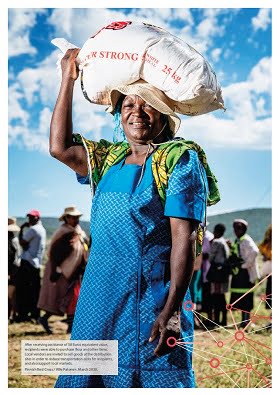
State of the World’s Cash 2020 – Chapter 2: Mainstreaming CVA – Progress; Risks and Challenges
Report
CVA is an increasingly common and well-understood tool in humanitarian response – 85% of practitioners perceive that there has been more systematic consideration of CVA over the last 2 years.This chapter asks: ‘How can ambitions for scaling up CVA be met whilst also pushing for better, more...
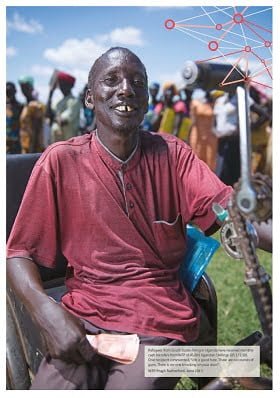
State of the World’s Cash 2020 – Chapter 3: Quality Programming
Report
67% of practitioners report that the quality of CVA has increased in the last two years. The focus for improving CVA has gradually shifted from increased scale, to improved quality and more recently towards quality as defined by outcomes for recipients. This chapter asks: ‘How can we continue to...

Cash and Voucher Assistance (CVA) and Partnership Toolkit
Guidelines and Tools
This year(2020) has called for a strong reflection on what we mean by partnership and how we work responsibly within CVA programs in support of localizaiton. For example, what do equitable and equal partnerships look like and why they are critical for accountable and quality humanitarian programs? In what...

Cash and Voucher Assistance (CVA) and Partnership Toolkit – 10 principles
Guidelines and Tools
This year(2020) has called for a strong reflection on what we mean by partnership and how we work responsibly within CVA programs in support of localizaiton. For example, what do equitable and equal partnerships look like and why they are critical for accountable and quality humanitarian programs? In what...

Cash and Voucher Assistance (CVA) and Partnership Toolkit – Partnering Project Cycles
Guidelines and Tools
This year(2020) has called for a strong reflection on what we mean by partnership and how we work responsibly within CVA programs in support of localizaiton. For example, what do equitable and equal partnerships look like and why they are critical for accountable and quality humanitarian programs? In what...

Cash and Voucher Assistance (CVA) and Partnership Toolkit – Good Practices & Guiding Questions
Guidelines and Tools
This document outlines in detail steps and considerations in Cash and Voucher Assistance (CVA) programs that are supporting of Local Humanitarian Leadership, align with principled and effective partnerships and follow minimum quality standards for partnerships across each phase of the CVA project cycle.
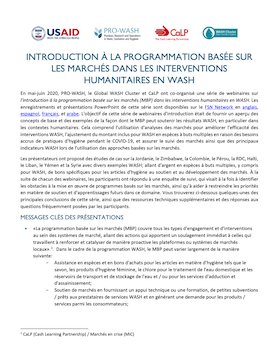
Introduction à la Programmation Basée sur les Marchés dans les Interventions Humanitaires en Wash
Guides et outils
En mai-juin 2020, PRO-WASH, le Global WASH Cluster et le CALP Network ont co-organisé une série de webinaires sur l’introduction à la programmation basée sur les marchés (MBP) dans les interventions humanitaires en WASH. Les enregistrements et présentations PowerPoint de cette série...
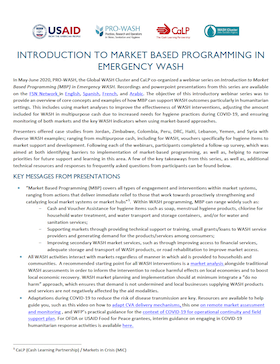
Introduction to Market based Programming in Emergency Wash
Guidelines and Tools
In May-June 2020, PRO-WASH, the Global WASH Cluster and the CALP Network co-organised a webinar series on Introduction to Market-Based Programming (MBP) in Emergency WASH. Recordings and Powerpoint presentations from this series are available on the FSN Network in English, Spanish, French and Arabic....

CVA and GBV webinar series for gender and cash subworkstream 2020
Webinar recording
Cash and voucher assistance (CVA) is now a common tool in humanitarian action used to meet the diverse needs of those displaced by crisis and conflict, and it is on the rise. Despite a push by several humanitarian actors since 2015, its use for protection outcomes – including to support the prevention...

COVID-19 impacts on Prices and Markets in Iraq
Report
The COVID-19 crisis in Iraq has caused severe economic disruptions in Iraq that will affect vulnerable households the most. The Cash Consortium for Iraq (CCI) has two streams of ongoing data collection on prices and markets, monitoring the retailer and the consumer perspective across five governorates....